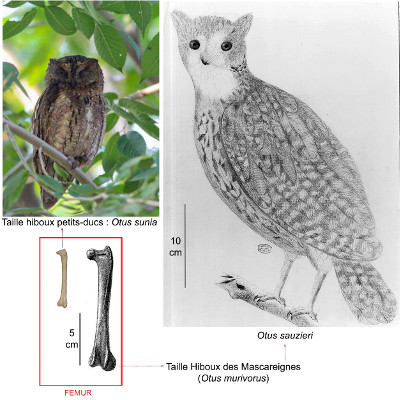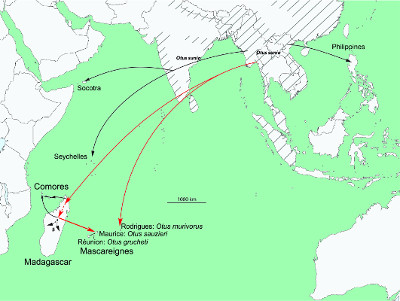A fate parallel to that of the dodo and solitaire

Abstract: Among the insular endemic bird species of the Mascarene Islands (Réunion, Mauritius, Rodrigues), in the southwestern Indian Ocean, were three species of « giant » owls, one on each island, extinct a few centuries ago like the dodo of Mauritius, due to human impacts. Hitherto enigmatic, their precise origins is now deciphered through the analysis of mitochondrial DNA fragments preserved in the fossils of two of these species. Otus sauzieri (Mauritius) and O. murivorus (Rodrigues) stem from the colonisation of these islands by the direct ancestor of O. sunia, the Oriental scops-owl, which lives today in southeast Asia. These colonisations were helped by cyclonic events, with similar pathways to present-day ones, but stronger and more frequent, in the Pliocene. On their respective island, the three species underwent doubling of body size through time ; this giantism phenomenon, frequent on islands, was accompanied by modifications of proportions of different body parts according to the species (skull, orbits, wings, legs …).
The biodiversity crisis due to human impacts started centuries ago, especially on islands across the world’s oceans. Since prehistoric times, as soon as human populations became established on oceanic islands, they had disastrous impacts on the indigenous environment, comprising a high proportion of endemic species. Numerous extinctions ensued. A second wave of colonisation, due to europeans principally, since the 15th century, produced similar effects, accentuating insular endemic species extinctions. The causes repeated many times : alteration of habitats (deforestation), over-hunting of certain species, introduction of commensal or domestic animals (rats, cats, dogs, pigs …) figure among the main ones. Among birds, many endemic species had evolved on these islands for millions of years without mammalian predators, or even generally without large reptiles, thus evolving toward a terrestrial way of life, and even in many cases losing the ability to fly. Several also lost all fear of predators which they never encountered. Theferore, the anthropic impacts had rapid and profound consequences, many bird species becaming extinct within tens or hundreds of years. Roughly half the species became extinct on each of the islands of the Pacific and other oceans. Thereby, the number of extinct species on islands due to man is estimated over 1500, equivalent to a decline of near 15% in global avian diversity (today ca 10 000 species).
From the viewpoint of evolutionary history, the study of the remains of these recently extinct species is therefore crucial to get a non-biased appreciation. On the Mascarene islands (Réunion , Mauritius, Rodrigues), « only » the european wave of colonisation occurred, but nevertheless was as disastrous as the two waves on many other islands elsewhere. Alongside the dodo and the solitaire, three enigmatic species of owls lived there, one of each island. Hitherto placed in an exclusive genus Mascarenotus, they are known through fossils (the three species), as well as ancient explorers relations (Mauritius and Rodrigues) and even a detailed description of a naturalised specimen and a drawing (Mauritius). These owls, giant (Image 1) when compared with the scops-owls (Otus) which seem to be related, were hitherto enigmatic, in particular relative to the precise origin of the continental species ancestral to them, and which colonised the islands. The possible candidates were all around the Indian Ocean.
A research team comprising the team of Paleogenomics and the PALGENE national platform of paleogenetics (ENS de Lyon), and researchers from the Laboratoire de Géologie de Lyon, analysed ancient DNA from fossils of these owls, in order to resolve the issue of their origins, and thereby of their remarkable insular evolutionary history.
Published in Journal of Biogeography, this study reveals fragments of cytochrome b from two species (‘Mascarenotus’ sauzieri from Mauritius, and ‘M.’ murivorus from Rodrigues). These mitochondrial sequences make it possible to place these species in the phylogenetic tree of extant owls, precisely. This study reveals that the ancestral lineage is that of the extant Oriental scops-owls, Otus sunia, of southeast Asia (Image 1). The colonisation pathways followed by this species from southeast Asia to the Mascarenes could be traced, and are in accordance with those known for extant scops-owls of other Indian Ocean islands (Comores, Madagascar, Seychelles) (Image 2).

This origin dating to 3.5 million years ago approximately is concordant with what we known of cyclonic events, their pathways similar to present-day cyclones, and their greater intensity and frequency in the Pliocene. Such cyclones, in the autumn, could carry individuals repeatedly over long distances far away from their normal migration route (which is today from southeast Asia to Indonesia, in O. sunia). These colonisation pathways resemble that of the ancestor of the dodo and the solitaire, a continental pigeon from the same region (and which colonised the Mascarenes much earlier, in the Oligocene).
The Mascarene owls can therefore be placed in the genus Otus, and beyond that, the precise identification of their ancestor allows for understanding their evolutionary trajectories on their respective island. In parallel, Otus sauzieri and O. murivorus underwent body size doubling (and O. grucheti of Réunion as well) (Image 1). The three species underwent a slight wing reduction. Finally, O. grucheti and O. sauzieri underwent a relative lengthening of legs, whereas those of O. murivorus became more robust. The evolution of the plumage of O. sauzieri can be traced as well. All these characteristics have adaptive causes which comprise the size of prey made available by absence of other owls (size), increased sedentariness (wing reduction), and different adaptations to different perches (legs). More intriguing, the researchers indentified indications of decrease in skull and orbits size, the causes of which are not clearly identified.
Thus, ancient mitochondrial DNA fragments preserved under unfavourable conditions (humid tropical climate) made it possible for the first time to considerably precise the phylogenetic position of these enigmatic owls, and thereby the conditions of the island colonisation by their ancestor, and their insular evolution.
Source: Ancient DNA reveals the origins, colonisation histories and evolutionary pathways of two recently extinct species of giant scops owl from Mauritius and Rodrigues Islands (Mascarene Islands, southwestern Indian Ocean). Antoine Louchart, Fabiola Bastian, Marilia Baptista, Perle Guarino-Vignon, Julian P. Hume, Cécile Jacot-des-Combes, Cécile Mourer-Chauvire, Catherine Hänni, Morgane Ollivier. Journal of Biogeography, 2018.






